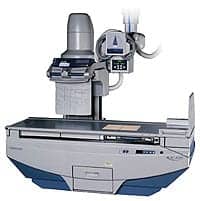Clinical/biomedical engineers have traditionally dealt with the physical properties of this world: mechanics, engineering, physics. Today, they must also incorporate less tangible concepts: communications, judgment, and forecasting. For instance, with x-rays, how to choose between computed radiography (CR) and digital radiography (DR), and in-house or contract? The decisions require reason and logic, but also a little bit of foresight and prediction. Fortunately, there are tools and processes to help departments make wise decisions. Databases and analytical software, together with experience, enable biomeds to answer these types of questions in ways that benefit their institutions and create higher equipment value, better returns, greater uptime, more satisfied customers, and, improved patient care.
When it comes to acquisition decisions in the imaging department, and specifically x-ray, biomeds may be asked to provide input on reliability, expected service expenses, and life cycle costs. CR and DR each have their advantages and disadvantages from both a clinical and clinical engineering perspective; the same can be said of the choice between in-house service and service contracts. Asking the right questions and finding the right answers in terms that are specific to the facility can facilitate evidence-based decision-making—putting biomeds back in the realm of science even while trying to predict the future.
CR Versus DR: The Facts
CR and DR are very similar in terms of their working concepts, yet different enough in their execution to create disparities impacting resources. These dissimilarities will often influence decisions regarding which type of system to employ.
Both CR and DR systems use x-ray energy to capture anatomical images, both produce the images much more quickly than conventional x-ray technology, and both allow software manipulation of the images. Their similarities typically end there.
During CR exams, the image is captured on a plate made of photostimulable phosphor. The plate is held within a specialized cassette, which is placed behind the anatomy to be imaged. The cassette is then recycled, and the plate is run through a digitizer or CR reader, essentially a specialized laser scanner. The resulting image is then transmitted to a computer, where the technologist can review and manipulate it.
DR technology eliminates the middle steps along with the associated accessories and consumables by capturing images directly onto electronic detectors, often flat panels made of amorphous silicon. “It eliminates having to use a cassette, expose that cassette, and run it through an imaging device to get that image,” says John Pelucacci, biomedical radiology technician with Pocono Health System in East Stroudsburg, Pa. “With DR, you just position the patient, take your x-ray, and within a matter of a couple of seconds that image is present.”
CR Versus DR: The Analysis

DR eliminates CR’s middle steps, along with the associated accessories, by capturing images directly onto electronic detectors.
Clinically, this means DR machines are faster, resulting in increased patient volumes. But DR machines also cost more. Bob Hedderman, a radiology equipment specialist at UPMC in Pittsburgh, estimates that a new DR detector can cost more than $150,000. In contrast, Pelucacci notes that replacing a CR plate costs between $1,000 and $2,000.
A facility must decide if it has a volume that justifies the additional expense and allows a healthy return on investment. That “return” can be seen in the biomed department with potentially less costly DR service (in terms of biomed time and equipment costs). “CR requires more hours of service or labor than DR systems simply because there are more mechanical parts involved,” Hedderman says.
Not only do the parts move within the system, but they are also moved around the system, introducing greater risk for damage. “Plates get jammed in the digitizer if you don’t keep the rollers clean,” Pelucacci says. “The suction cups should be changed regularly. And if you don’t keep up with the maintenance, it could damage the plate.”
Maintained properly, it is possible to limit these CR expenses. “Service cost for CR can be quite low, depending on the system and whether or not the department is managing the cassettes,” says Jeremy Shankle, imaging engineer in the clinical engineering department at Duke University Health System, Durham, NC. “If a clinical engineering department is covering the CR unit only, with radiology managing cassette repair and replacement, there isn’t much liability.” However, damage enough CR plates, and the cost could begin to rival that of a DR detector.
Though more expensive, DR machines—comprised of fewer parts—tend to be very reliable and typically have fewer service and maintenance requirements than CR devices. “I think it’s definitely worth spending the extra money for DR equipment, until you have to replace one of your detectors,” Hedderman says. “Then it might not be worth it unless you get a service contract. You’re always going to have to weigh those issues.”
In-house Versus Contract: The Benefits
“Advantages to servicing in-house would be response time and savings from removing the contract,” Shankle says.
Improved response time has the most direct impact on patient care. In-house service can usually respond much more quickly than an outside vendor, which translates into less interruption in the clinical process and patient schedules. “One of the biggest advantages, I feel, is the response time and uptime of equipment,” Pelucacci says. “With in-house, they’re able to pick up the phone and call me, and I can go right down and address the situation.” If Pelucacci has the necessary parts in-house, he can fix it immediately or he can have them overnighted. “If something is under contract, you’re waiting,” Pelucacci says. “You place your call, wait a couple of hours for the technician to respond, and then, if the technician gets out here and he needs to order parts, you’re waiting a day or two for parts.”
In addition, “There are some distinct advantages for the in-house group who can be aware of possible other local issues that may affect the CR/DR systems,” Shankle says. “The OEM may not have that advantage.”
In an institution such as the Pocono Health System, the time to make up for outside service can be costly in more ways than lost revenue. The facility operates the state’s second-busiest emergency department, according to Pelucacci. “We see more than 90,000 patients through our emergency department,” he says. In such high-volume situations, DR can be a better option because it enables faster turnarounds and greater volumes.
In-house Versus Contract: The Risks
But again, the associated costs can be high, extending well beyond the initial investment if repair becomes replacement. “If something fails in the detector, you’re looking at a six-figure cost to replace it,” Pelucacci says. A contract helps to remove uncertainty and provide predictable numbers for budgets.
To determine whether the risk may be worth it, biomeds should consider the equipment’s reliability. “If the model you are considering servicing in-house has a high rate of detector loss, then the cost to maintain it would probably outweigh the savings from removing the contract,” Shankle says. “However, if the model has been very reliable in the past, then servicing in-house could provide a higher cost savings.”
At Duke, the clinical engineering department manages all service and preventive maintenance on its CR systems. DR rooms are mixed with many handled in-house and a few covered under shared agreements, where the vendor handles the detector. Retrofitted wireless detectors remain under full service contracts and have protection coverage in case of accidental damage.
Innovations in DR with portable detectors have provided definite clinical advantages and definite service and maintenance disadvantages—anytime equipment is hands-on, there is a greater risk of accidental damage. “With technicians being able to carry around [the portable detector], the chances of them dropping it and damaging it go up substantially,” Pelucacci says.
Subsequently, biomed experts in imaging recommend keeping these particular devices under a contract negotiated to include accidental damage. Other factors to consider in a service agreement include knowing about the company’s history and reputation, the quality of its products and service offerings, the availability of technical support, the level of responsiveness, and the opportunity for training. Is the product user friendly, DICOM compatible, reliable, reasonably priced? Are loaners possible? Will it integrate with the facility’s other systems? Can it be upgraded? “You don’t want to spend hundreds of thousands of dollars on something that you find out down the road can’t be upgraded,” Pelucacci says.
Of course, biomed departments often provide input but do not necessarily make the decision. “We have a lot of involvement with prepurchasing evaluation, but we never tell a department what they can and can’t buy,” Pelucacci says. “We make suggestions from our experience and knowledge and what we think would be best.” Using evidence-based recommendations versus best guesswork puts biomeds back in the realm with which they are familiar: physical science.
Renee Diiulio is a contributing writer for 24×7. For more information, contact .





